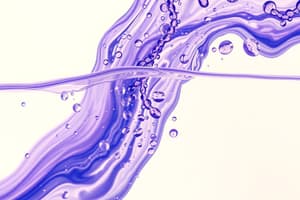Podcast
Questions and Answers
What factors determine the direction and amount of fluid flow across capillary walls?
What factors determine the direction and amount of fluid flow across capillary walls?
- Hydrostatic pressures
- Colloid osmotic pressures
- Both hydrostatic and colloid osmotic pressures (correct)
- None of the above
What is hydrostatic pressure (HP)?
What is hydrostatic pressure (HP)?
The force exerted by a fluid pressing against a wall.
What does HPc stand for?
What does HPc stand for?
Capillary hydrostatic pressure.
HPc is greater at the __________ end of the capillary bed than at the venule end.
HPc is greater at the __________ end of the capillary bed than at the venule end.
What is HPif?
What is HPif?
What are colloid osmotic pressures (COP)?
What are colloid osmotic pressures (COP)?
What is OPc?
What is OPc?
The pressure OPc is approximately __________ mm Hg.
The pressure OPc is approximately __________ mm Hg.
What is OPif and its significance?
What is OPif and its significance?
Study Notes
Fluid Dynamics Across Capillary Walls
- Fluid movement across capillary walls is influenced by hydrostatic and colloid osmotic pressures, which act in opposition.
Hydrostatic Pressure (HP)
- Defined as the force exerted by a fluid against a wall.
- In capillaries, HP equals capillary blood pressure, which is blood pressure on the walls of capillaries.
- It consists of two types:
- Capillary Hydrostatic Pressure (HPc): The pressure that drives fluid out of the capillaries.
- Interstitial Fluid Hydrostatic Pressure (HPif): The pressure that pushes fluid back into the capillary.
Capillary Hydrostatic Pressure (HPc)
- Represents the capillary blood pressure that drives fluid through the capillary walls.
- Pressure is higher at the arterial end (about 35 mm Hg) compared to the venule end (about 17 mm Hg).
Interstitial Fluid Hydrostatic Pressure (HPif)
- This pressure generally pushes fluid into the capillary.
- Often assumed to be zero due to drainage of interstitial fluid by lymphatic vessels.
Colloid Osmotic Pressures (COP)
- Oppose hydrostatic pressure and result from large nondiffusible molecules, primarily plasma proteins, which cannot cross capillary walls.
- Comprises two types:
- Capillary Colloid Osmotic Pressure (OPc, oncotic pressure): The "sucking" force pulling water back into capillaries due to plasma proteins. Average pressure is around 26 mm Hg.
- Interstitial Fluid Colloid Osmotic Pressure (OPif): Minimal pressure due to low protein content in interstitial fluid, approximately 1 mm Hg.
Summary of Key Pressures
- Hydrostatic and colloid osmotic pressures work together to regulate fluid exchange in capillaries, with HP pushing fluid out and COP pulling fluid in.
Studying That Suits You
Use AI to generate personalized quizzes and flashcards to suit your learning preferences.
Description
Explore the concepts of hydrostatic pressure and osmotic pressure in this flashcard quiz. Understand the forces that impact fluid flow across capillary walls, and learn how hydrostatic pressure is defined and applied within the circulatory system.




